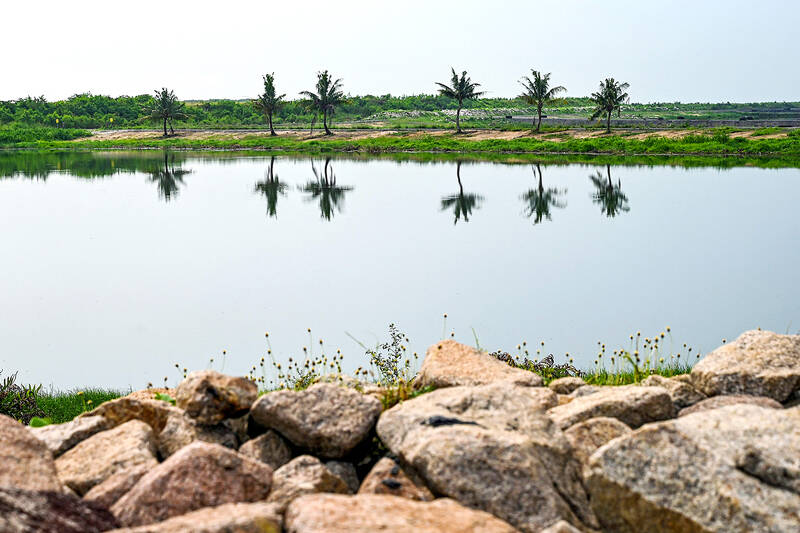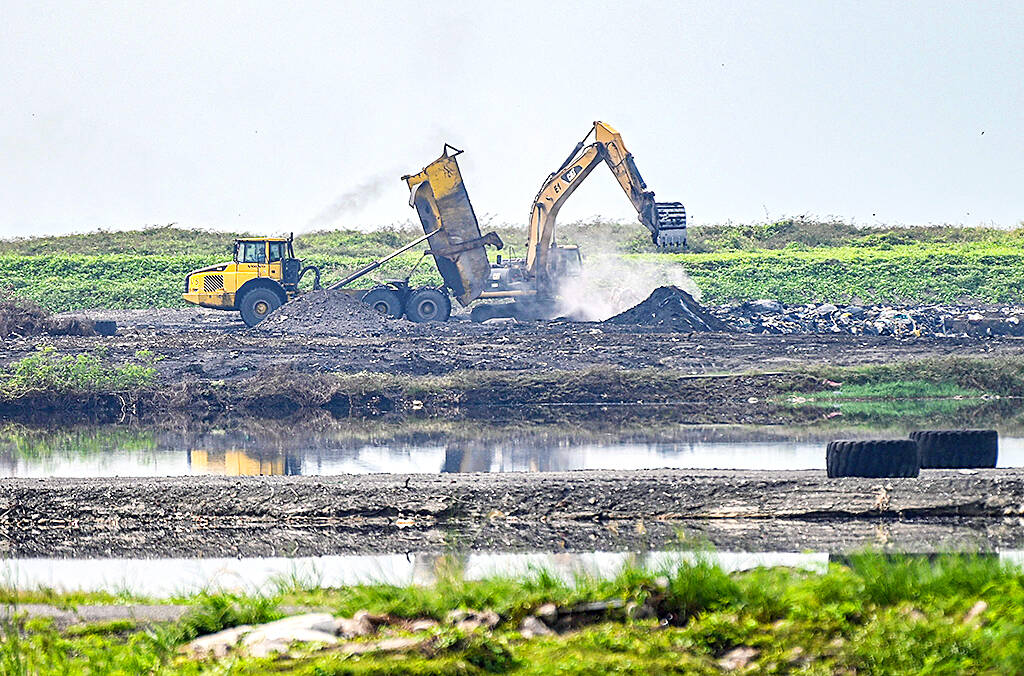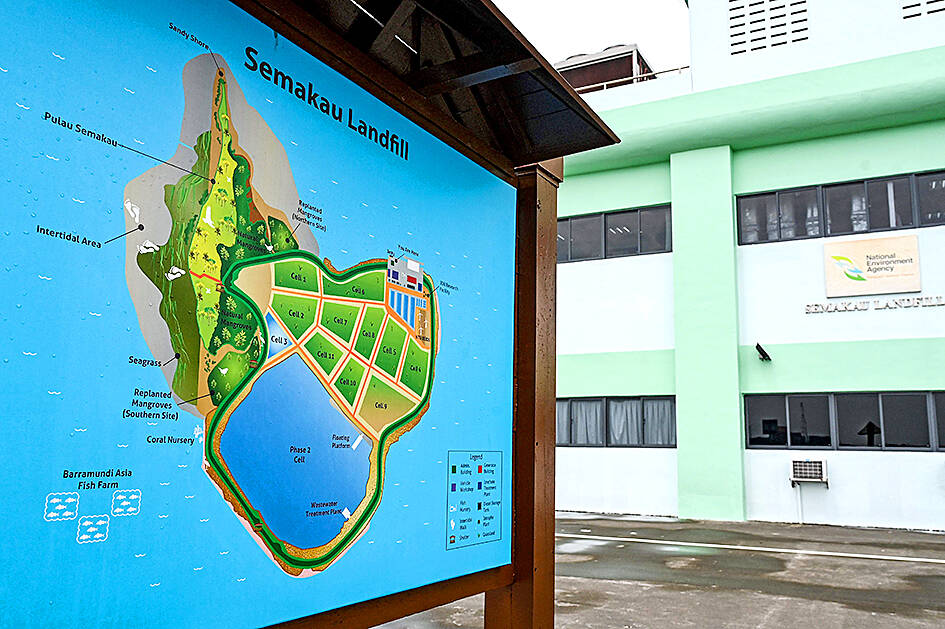Visitors to the island hosting Singapore’s only landfill might expect foul odors and swarms of flies, but instead they are greeted with stunning views of blue waters, lush greenery and wildlife.
Welcome to Pulau Semakau, the land-scarce city’s eco-friendly trash island, where ash from the incinerated garbage of its nearly six million people is dumped.
With just over a decade to go until the site is projected to be filled, the government is in a race against time to extend the lifespan of the island landfill, so serene it has earned the moniker “Garbage of Eden.”

Photo: AFP
“This is the only landfill in Singapore, and due to the small area and the competing land needs, it is difficult to find another location,” Desmond Lee, the landfill manager at the National Environment Agency (NEA), which oversees the island, says.
“It is imperative that we continue to use the Semakau landfill for as long as possible, and if possible extend its life beyond 2035,” he says.
Singapore generated 7.4 million tonnes of waste last year, of which about 4.2 million tonnes, or 57 percent, was recycled.

Photo: AFP
Plastics remain a sticking point for the island’s waste drive, with just 6 percent recycled last year. Food waste, of which 18 percent was recycled, also poses a problem.Environmental group Greenpeace criticized the city-state for producing a “massive” amount of waste for its size.
In 2019, the government launched a “zero-waste” campaign seeking to boost the amount of recycled waste to 70 percent and slash the amount of trash dumped at Semakau by 30 percent before the end of the decade.
Roughly the size of New York City, Singapore has carefully managed its rapid growth in recent decades to avoid the problems faced by other fast-developing Asian metropolises, such as overcrowding and undisposed garbage. The government built the offshore landfill after an inland waste depot began running out of space in the early 1990s.

Photo: AFP
Engineers merged Semakau — whose residents had earlier been resettled to the mainland — with the nearby island of Pulau Sakeng.
A 7km perimeter bund was constructed to enclose part of the open sea between the two islands and create space for the landfill, which began operating in 1999.
With Singapore’s population growing steadily, authorities were forced to roll out bold, space-saving solutions. Incinerators were deployed to burn non-recyclable waste, before authorities shipped the ash to Semakau on a covered barge.
But the practice of burning the rubbish has been criticized by environmental groups for its pollution.
“The process results in pollution in each of its phases — from waste hauling to managing air emissions and residues,” Abigail Aguilar, Greenpeace’s anti-plastics campaigner for Southeast Asia, said. “While aesthetically it might be appealing, the landfill still contains waste that could potentially leak.”
The NEA has said its incineration plants are fitted with treatment systems that clean the gas before they are released into the atmosphere.
It added that the landfill had been lined with an impermeable membrane and marine clay to contain any potential pollution within the site, and the water is tested regularly for leakage.
There could still be more use for Singapore’s garbage island, with plans to build solar farms and also to turn ash from the landfill into road construction materials.
After the barge docks on Semakau, earthmovers scoop the ash and load them onto giant yellow tipper trucks for the trip to the landfill, which has been subdivided into sections. As each pit is progressively filled up over the years, the area is covered with soil, allowing for the growth of natural vegetation.
Mangrove forests have also been planted, making the island verdant and attracting wildlife.
During a recent visit, a couple of brahminy kites were seen swooping down on the water to catch fish, while a white-bellied sea eagle circled above.
Red-wattled lapwings made bird calls on the edge of a mangrove patch and little terns maneuvered above a filled-up pit. A family of grebes swam on a pond, its dike lined with coconut trees.

May 26 to June 1 When the Qing Dynasty first took control over many parts of Taiwan in 1684, it roughly continued the Kingdom of Tungning’s administrative borders (see below), setting up one prefecture and three counties. The actual area of control covered today’s Chiayi, Tainan and Kaohsiung. The administrative center was in Taiwan Prefecture, in today’s Tainan. But as Han settlement expanded and due to rebellions and other international incidents, the administrative units became more complex. By the time Taiwan became a province of the Qing in 1887, there were three prefectures, eleven counties, three subprefectures and one directly-administered prefecture, with

It’s an enormous dome of colorful glass, something between the Sistine Chapel and a Marc Chagall fresco. And yet, it’s just a subway station. Formosa Boulevard is the heart of Kaohsiung’s mass transit system. In metro terms, it’s modest: the only transfer station in a network with just two lines. But it’s a landmark nonetheless: a civic space that serves as much more than a point of transit. On a hot Sunday, the corridors and vast halls are filled with a market selling everything from second-hand clothes to toys and house decorations. It’s just one of the many events the station hosts,

Among Thailand’s Chinese Nationalist Party (KMT) villages, a certain rivalry exists between Arunothai, the largest of these villages, and Mae Salong, which is currently the most prosperous. Historically, the rivalry stems from a split in KMT military factions in the early 1960s, which divided command and opium territories after Chiang Kai-shek (蔣介石) cut off open support in 1961 due to international pressure (see part two, “The KMT opium lords of the Golden Triangle,” on May 20). But today this rivalry manifests as a different kind of split, with Arunothai leading a pro-China faction and Mae Salong staunchly aligned to Taiwan.

Two moves show Taichung Mayor Lu Shiow-yen (盧秀燕) is gunning for Chinese Nationalist Party (KMT) party chair and the 2028 presidential election. Technically, these are not yet “officially” official, but by the rules of Taiwan politics, she is now on the dance floor. Earlier this month Lu confirmed in an interview in Japan’s Nikkei that she was considering running for KMT chair. This is not new news, but according to reports from her camp she previously was still considering the case for and against running. By choosing a respected, international news outlet, she declared it to the world. While the outside world